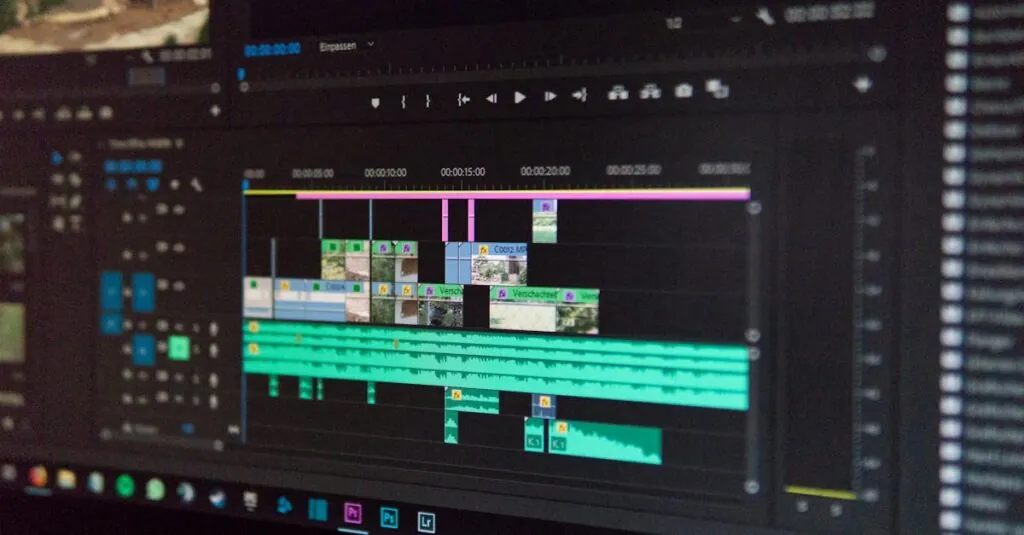In a world overflowing with data, turning numbers into visuals is like transforming a bowl of spaghetti into a gourmet meal. Enter data visualization tools—these magical wands of the digital realm that help make sense of the chaos. They don’t just dress up data; they create compelling stories that even your grandma would understand.
Imagine trying to explain your latest project findings using only a spreadsheet. Yawn, right? With the right visualization tools, you can create eye-catching charts and graphs that not only engage your audience but also make them nod in understanding. Whether you’re a seasoned analyst or just starting out, these tools can elevate your presentations from “meh” to “wow!” Let’s dive into the world of data visualization and discover how it can transform your insights into impactful narratives.
Overview of Data Visualization Tools
Data visualization tools serve a crucial role in effective data communication. They allow users to translate complex datasets into interactive and meaningful graphics. Commonly, these tools transform raw information into charts, graphs, and maps. Each visualization format helps highlight trends and patterns that might remain hidden in text-based data.
Numerous options exist among data visualization tools. Some examples include Tableau, Power BI, and Google Data Studio. Tableau offers robust capabilities for creating sophisticated visualizations. Power BI integrates well with Microsoft products, providing user-friendly features for business analytics. Google Data Studio enables users to create customizable dashboards using data from various sources.
Enabling collaboration, many tools provide sharing functionalities. Users can distribute visual reports across teams or departments. Real-time data updates enhance these tools, keeping visuals current and relevant. User interactivity features allow audience engagement with the data. This interaction supports deeper insights, fostering data-driven decision-making.
Organizations across various sectors leverage these tools. In finance, data visualizations help simplify complex investment portfolios. Marketing teams utilize them for analyzing campaign performance metrics. Education professionals enhance student engagement through interactive learning materials.
Data visualization tools elevate the understanding of information. They turn insights into compelling narratives that resonate with users. Emphasizing clarity and accessibility, these tools help broaden the reach of data-driven insights. Ultimately, they play a significant role in modern analytics, ensuring users harness the full potential of their data.
Key Features of Popular Tools
Data visualization tools possess various features that enhance their usability and efficiency for transforming complex data into meaningful insights.
User Interface and Experience
User interfaces in popular data visualization tools often prioritize simplicity and accessibility. Intuitive designs help users navigate through functionalities effectively. Drag-and-drop capabilities allow for quick arrangement of data elements. Tooltips and guided tutorials enhance user engagement and learning. Visual aesthetics, including color schemes and layout options, contribute to an effective storytelling experience. Users generally appreciate dashboards that offer quick access to key metrics. Familiarity with these tools can significantly reduce training time and increase productivity.
Data Integration Capabilities
Data integration stands out as a critical feature in data visualization tools. Seamless connections with various data sources simplify the data import process. Compatibility with databases, cloud services, and spreadsheets broadens users’ options. Automated data syncing features ensure visuals remain up-to-date with the latest data changes. Support for multiple file formats enhances versatility and eases user workflows. Integration with third-party applications often promotes collaboration and sharing within teams. Overall, robust data integration capabilities empower users to leverage diverse datasets efficiently.
Comparison of Top Data Visualization Tools
Data visualization tools play a crucial role in making complex data more accessible. Several options stand out in the market, offering unique features that cater to different user needs.
Tableau
Tableau excels at transforming raw data into interactive visualizations. Users appreciate its robust analytics capabilities and drag-and-drop interface, making it accessible for both beginners and advanced users. Data connections to numerous sources, including SQL databases and cloud services, facilitate seamless integration. Customizable dashboards enhance user engagement, allowing viewers to explore data dynamically. Organizations in various sectors value Tableau for its ability to deliver compelling insights quickly and effectively.
Power BI
Power BI integrates seamlessly with Microsoft products, making it an attractive option for enterprises already using Microsoft ecosystems. Users benefit from its rich array of visualization options, which can showcase insights in visually appealing formats. The tool includes natural language processing capabilities, allowing users to interact with data through conversational queries. Monthly updates often introduce new features, ensuring that Power BI remains competitive in the evolving analytics landscape. Many businesses rely on Power BI for its cost-effectiveness and ease of collaboration among team members.
Google Data Studio
Google Data Studio provides a user-friendly platform with a focus on collaboration. Users can create customizable reports that connect to multiple Google services like Google Analytics and Google Sheets. Real-time data updates ensure that visualizations reflect the latest changes, promoting informed decision-making. Audience engagement increases through interactive elements embedded in reports, facilitating deeper analysis. Its free access makes Google Data Studio an appealing choice for startups and small businesses looking to leverage data insights without significant investment.
Benefits of Using Data Visualization Tools
Data visualization tools enhance the communication of insights derived from complex datasets. Clarity arises when visual elements like charts and graphs represent data, enabling users to comprehend trends quickly. Engagement increases significantly as visuals capture attention more effectively than raw numbers.
Improved decision-making is another key advantage. Organizations leverage these tools to analyze data in real-time, enabling timely responses to emerging trends. Enhanced collaboration features encourage team members to share visual reports easily, fostering a cooperative approach to data analysis.
User adoption benefits from intuitive interfaces that many tools provide. A smooth learning curve allows users to focus on data interpretation rather than technical skills. Integration capabilities further streamline workflows, connecting effortlessly with various data sources and automating updates.
Accessibility emerges as an additional strength. Stakeholders at different levels can interpret visuals without needing advanced analytical skills. This democratization of data encourages a broader audience to participate in data-driven discussions.
Suitability for various sectors showcases the versatility of these tools. Tableau’s robust analytics apply well in finance, while Power BI’s compatibility with Microsoft products aligns perfectly in corporate environments. Google Data Studio’s real-time data features appeal to startups focused on agility and responsiveness.
Ultimately, the collective benefits of using data visualization tools support organizations in conveying impactful narratives. Enhanced clarity, improved decision-making, and increased accessibility collectively transform how teams approach data analysis and reporting.
Best Practices for Effective Data Visualization
Choose the right type of visualization. Selecting between bar charts, line graphs, or pie charts depends on the data you’re presenting. Each type serves a unique purpose and conveys information differently.
Utilize color effectively. Using color can draw attention to key data points and establish a visual hierarchy. Aim for a balanced palette to ensure clarity without overwhelming viewers.
Keep it simple. Overloading visuals with too much information can lead to confusion. Focus on the essential insights, and eliminate unnecessary elements that don’t enhance understanding.
Provide context. Contextualizing data through titles, labels, and annotations clarifies the visual’s purpose. Clear descriptions help audiences grasp the significance of the presented information.
Incorporate interactivity. Interactive features foster user engagement and allow for personalized exploration of the data. Interactive elements like filters and tooltips enhance the overall experience and encourage deeper analysis.
Maintain consistency. Consistent design elements, such as fonts and colors, streamlines the visual experience. Cohesive visuals build trust and brand recognition over time.
Test with your audience. Gathering feedback from the intended audience can reveal insights about clarity and effectiveness. Iterating based on real user experiences enhances the final product’s impact.
Prioritize accessibility. Ensuring visuals are accessible to all, including those with disabilities, broadens the reach of the data. Using alt text for images and checking color contrast improve comprehension for everyone.
Collaborate with stakeholders. Involving team members in the visualization process garners diverse perspectives. Collaboration fosters creativity and results in more comprehensive visual narratives.
Review for accuracy. Double-check data sources and calculations to prevent errors. Reviewing visuals ensures that they accurately represent the insights intended for communication.
Adopting these best practices leads to more effective data visualization, making information accessible and engaging across various sectors.
Data visualization tools are essential for turning complex datasets into clear and engaging visuals. By enhancing the way insights are communicated these tools empower organizations to make informed decisions quickly. The variety of options available ensures that there’s a suitable tool for every user need from intuitive platforms like Google Data Studio to robust solutions like Tableau and Power BI.
Adopting best practices in data visualization not only improves clarity but also fosters collaboration among teams. As organizations continue to embrace data-driven strategies the importance of effective visualization will only grow. Investing in the right tools and techniques can transform data analysis and storytelling making it accessible and impactful for all stakeholders involved.












